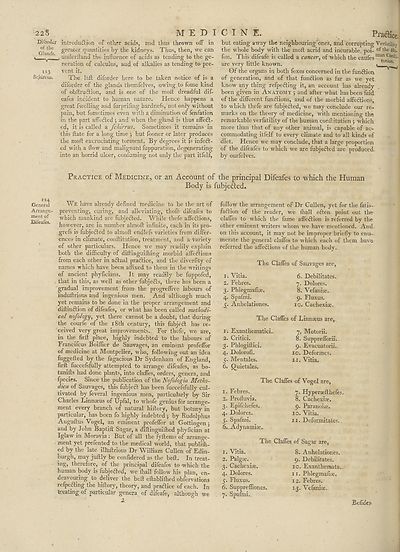Encyclopaedia Britannica, or, a Dictionary of arts, sciences, and miscellaneous literature : enlarged and improved. Illustrated with nearly six hundred engravings > Volume 13, MAT-MIC
(270) Page 228
Download files
Complete book:
Individual page:
Thumbnail gallery: Grid view | List view

22$ M E D I
Difortlcr introduction of other acids, and thus thrown off in
Giants 8Teaicr quantities by the kidneys. Thus, then, we can
t . underftand the influence of acids as tending to the ge¬
neration of calculus, and of alkalies as tending to pre-
*23 vent it.
Schirms. The lafi; diforder here to be taken notice of is a
diforder of the glands themfelves, owing to fome kind
of obllrudlion, and is one of the moil dreadful dif-
eafes incident to human nature. Hence happens a
great fwclling and furpriling hardnefs, not only without
pain, but fometimes even with a diminution of fenfatibn
in the part affedled 5 and when the gland is thus a fleet¬
ed, it is called a fchirrus. Sometimes it remains in
this date for a long time 5 but fooner or later produces
llie mofl: excruciating torment. By degrees it is infedl-
ed with a flow and malignant fuppuration, degenerating
into an horrid ulcer, confuming not only the part itfelf,
CINE. ^ .. Pradice,
but eating away the n ei glib curing ones, and corrupting Verfatility
the whole body with the mofl: acrid and incurable , poi- d“e Hu.
fon. This difeafe is called a cancer, of which the caufes man
are very little known. . tutIon-^
Qf the organs in both fexes concerned in the fundlion
of generation, and of that fundlion as far as we yet
know any thing refpe&ing it, an account has already
been given in Anatomy ; and after what has been faid
of the different fundlions, and of the morbid affedlions,
to which thefe are fubjected, we may conclude our re¬
marks on the theory of medicine, with mentioning the
remarkable verfatility of the human conftitution 5 which
more than that of any other animal, is capable of ac¬
commodating itfelf to every climate and to all kinds of
diet. Hence we may conclude, that a large proportion
of the difeafes to which we are fubjedled are produced
by ourfelves.
Practice of Medicine, or an Account of the principal Difeafes to which the Human
Body is fubjeded.
General We have already defined medicine to be the art of
Arrange- preventing, curing, and alleviating, thofe difeafes to
Difntf ^ which mankind are fubjedted. While thefe affections,
1 ’ however, are in number almofi: infinite, each in its pro-
grefs is fubjedled to almofl: endlefs varieties from differ¬
ences in climate, conftitution, treatment, and a Variety
of other particulars. Hence wm may readily explain
both the difficulty of diftinguiftiing morbid affedfions
from each other in actual pradtice, and the diverlity of
names which have, been affixed to them in the writings
of ancient phyficians. It may readily be fuppofed,
that in this, as well as other fubjedts, there has been a
gradual improvement from the progreffive labours of
ihduftrious and ingenious men. And although much
yet remains to be done in the proper arrangement and
diftindtion of difeafes, or what has been called methodi¬
cal nofology, yet there cannot be a doubt, that during
the courfe of the 18th century, this fubjedl has re¬
ceived very great improvements... For thefe, we are,
in the firft place, highly indebted to the labours of
Francifcus Boiffier de Sauvages, an eminent profeffor
of medicine at Montpelier, who, following out an idea
fuggefted by the fagacious Dr Sydenham of England,
firft fuccefsfully attempted to arrange difeafes, as bo-
tanifts had done plants, into claffes, orders, genera, and
fpecies. Since the publication of the Nofologia Metho-
dica of Sauvages, this fubjedl has been fuccefsfully cul¬
tivated by feveral ingenious men, particularly by Sir
Charles Linnaeus of Upfal, to whofe genius for arrange¬
ment every branch of natural hiftory, but botany in
particular, has been fo highly indebted 5 by Rudolphus
Auguftus Vogel, an eminent profeffor at Gottingen j
and by John Baptift Sagar, a diftinguiftied phyfician at
Igiaw in Moravia : But of all the fyftems of arrange¬
ment yet prefented to the medical world, that publifti-
ed by the late illuftrious Dr William Cullen of Edin¬
burgh, may juftly be confidered as the beft. In treat¬
ing, therefore, of the principal difeafes to which the
human body is fubjeaed, we flrall follow his plan, en¬
deavouring to deliver the beft eftabliffied obfervations
refpeaing the hiftory, theory, and praaice of each. In
Seating of particular genera of difeafe, although we
2.
follow the arrangement of Dr Cullen, yet for the fatis-
faaion of the reader, wre Ihall often point out the
elaffes to which the fame affeaion is referred, by the
other eminent writers whom we have mentioned. And
on this account, it may not be improper briefly to enu¬
merate the general claffes to which each of them have
referred the affbaions of the human body..
The Claffes of Sauvages arc,
j. Vitia.
2. Febres.
3. Phlegmafise.
4. Spafmi.
3. Anhelationes.
6. Debilitates.
7. Dolores.
8. Vefaniae.
9. Fluxus.
10. Cachexiae.
The Claffes of Linnaeus are,
1. Exanthematici.
2. Critici.
3. Phlogiftici.
4. Dolorofi.
5. Mentales.
6. Quietales.
7. Motorii.
8. Supprefforii.
9. Evacuatorii.
10. Deformes.
11. Vitia.
The Claffes of Vogel are.
1. Febres.
2. Profluvia.
3. Epifchefes.
4. Dolores.
5. Spafmi.
6...Adynamise.
7. Hyperaefthefes.
8. Cachexiae.
9. Paranoia?.
10. Vitia.
11. Deformitates.
The Claffes of Sagar are,
1. Vitia.
2. Palgae.
3. Cachexiae.
4. Dolores.
5. Fluxus.
6. Suppreffiones.
7. Spafmi.
8. Anhelationes.
9. Debilitates.
10. Exanthemata.
11. Phlegmafiae.
12. Febres.
13. Vefanias.
Befides
Difortlcr introduction of other acids, and thus thrown off in
Giants 8Teaicr quantities by the kidneys. Thus, then, we can
t . underftand the influence of acids as tending to the ge¬
neration of calculus, and of alkalies as tending to pre-
*23 vent it.
Schirms. The lafi; diforder here to be taken notice of is a
diforder of the glands themfelves, owing to fome kind
of obllrudlion, and is one of the moil dreadful dif-
eafes incident to human nature. Hence happens a
great fwclling and furpriling hardnefs, not only without
pain, but fometimes even with a diminution of fenfatibn
in the part affedled 5 and when the gland is thus a fleet¬
ed, it is called a fchirrus. Sometimes it remains in
this date for a long time 5 but fooner or later produces
llie mofl: excruciating torment. By degrees it is infedl-
ed with a flow and malignant fuppuration, degenerating
into an horrid ulcer, confuming not only the part itfelf,
CINE. ^ .. Pradice,
but eating away the n ei glib curing ones, and corrupting Verfatility
the whole body with the mofl: acrid and incurable , poi- d“e Hu.
fon. This difeafe is called a cancer, of which the caufes man
are very little known. . tutIon-^
Qf the organs in both fexes concerned in the fundlion
of generation, and of that fundlion as far as we yet
know any thing refpe&ing it, an account has already
been given in Anatomy ; and after what has been faid
of the different fundlions, and of the morbid affedlions,
to which thefe are fubjected, we may conclude our re¬
marks on the theory of medicine, with mentioning the
remarkable verfatility of the human conftitution 5 which
more than that of any other animal, is capable of ac¬
commodating itfelf to every climate and to all kinds of
diet. Hence we may conclude, that a large proportion
of the difeafes to which we are fubjedled are produced
by ourfelves.
Practice of Medicine, or an Account of the principal Difeafes to which the Human
Body is fubjeded.
General We have already defined medicine to be the art of
Arrange- preventing, curing, and alleviating, thofe difeafes to
Difntf ^ which mankind are fubjedted. While thefe affections,
1 ’ however, are in number almofi: infinite, each in its pro-
grefs is fubjedled to almofl: endlefs varieties from differ¬
ences in climate, conftitution, treatment, and a Variety
of other particulars. Hence wm may readily explain
both the difficulty of diftinguiftiing morbid affedfions
from each other in actual pradtice, and the diverlity of
names which have, been affixed to them in the writings
of ancient phyficians. It may readily be fuppofed,
that in this, as well as other fubjedts, there has been a
gradual improvement from the progreffive labours of
ihduftrious and ingenious men. And although much
yet remains to be done in the proper arrangement and
diftindtion of difeafes, or what has been called methodi¬
cal nofology, yet there cannot be a doubt, that during
the courfe of the 18th century, this fubjedl has re¬
ceived very great improvements... For thefe, we are,
in the firft place, highly indebted to the labours of
Francifcus Boiffier de Sauvages, an eminent profeffor
of medicine at Montpelier, who, following out an idea
fuggefted by the fagacious Dr Sydenham of England,
firft fuccefsfully attempted to arrange difeafes, as bo-
tanifts had done plants, into claffes, orders, genera, and
fpecies. Since the publication of the Nofologia Metho-
dica of Sauvages, this fubjedl has been fuccefsfully cul¬
tivated by feveral ingenious men, particularly by Sir
Charles Linnaeus of Upfal, to whofe genius for arrange¬
ment every branch of natural hiftory, but botany in
particular, has been fo highly indebted 5 by Rudolphus
Auguftus Vogel, an eminent profeffor at Gottingen j
and by John Baptift Sagar, a diftinguiftied phyfician at
Igiaw in Moravia : But of all the fyftems of arrange¬
ment yet prefented to the medical world, that publifti-
ed by the late illuftrious Dr William Cullen of Edin¬
burgh, may juftly be confidered as the beft. In treat¬
ing, therefore, of the principal difeafes to which the
human body is fubjeaed, we flrall follow his plan, en¬
deavouring to deliver the beft eftabliffied obfervations
refpeaing the hiftory, theory, and praaice of each. In
Seating of particular genera of difeafe, although we
2.
follow the arrangement of Dr Cullen, yet for the fatis-
faaion of the reader, wre Ihall often point out the
elaffes to which the fame affeaion is referred, by the
other eminent writers whom we have mentioned. And
on this account, it may not be improper briefly to enu¬
merate the general claffes to which each of them have
referred the affbaions of the human body..
The Claffes of Sauvages arc,
j. Vitia.
2. Febres.
3. Phlegmafise.
4. Spafmi.
3. Anhelationes.
6. Debilitates.
7. Dolores.
8. Vefaniae.
9. Fluxus.
10. Cachexiae.
The Claffes of Linnaeus are,
1. Exanthematici.
2. Critici.
3. Phlogiftici.
4. Dolorofi.
5. Mentales.
6. Quietales.
7. Motorii.
8. Supprefforii.
9. Evacuatorii.
10. Deformes.
11. Vitia.
The Claffes of Vogel are.
1. Febres.
2. Profluvia.
3. Epifchefes.
4. Dolores.
5. Spafmi.
6...Adynamise.
7. Hyperaefthefes.
8. Cachexiae.
9. Paranoia?.
10. Vitia.
11. Deformitates.
The Claffes of Sagar are,
1. Vitia.
2. Palgae.
3. Cachexiae.
4. Dolores.
5. Fluxus.
6. Suppreffiones.
7. Spafmi.
8. Anhelationes.
9. Debilitates.
10. Exanthemata.
11. Phlegmafiae.
12. Febres.
13. Vefanias.
Befides
Set display mode to:
![]() Universal Viewer |
Universal Viewer | ![]() Mirador |
Large image | Transcription
Mirador |
Large image | Transcription
Images and transcriptions on this page, including medium image downloads, may be used under the Creative Commons Attribution 4.0 International Licence unless otherwise stated. ![]()
| Permanent URL | https://digital.nls.uk/192664672 |
|---|
| Attribution and copyright: |
|
|---|
| Description | Ten editions of 'Encyclopaedia Britannica', issued from 1768-1903, in 231 volumes. Originally issued in 100 weekly parts (3 volumes) between 1768 and 1771 by publishers: Colin Macfarquhar and Andrew Bell (Edinburgh); editor: William Smellie: engraver: Andrew Bell. Expanded editions in the 19th century featured more volumes and contributions from leading experts in their fields. Managed and published in Edinburgh up to the 9th edition (25 volumes, from 1875-1889); the 10th edition (1902-1903) re-issued the 9th edition, with 11 supplementary volumes. |
|---|---|
| Additional NLS resources: |
|

